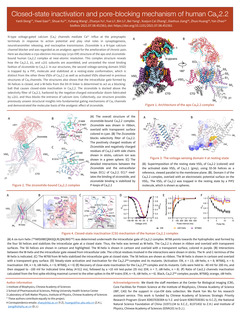Closed-state inactivation and pore-blocking mechanism of human CaV2.2
ID:48
Submission ID:46 View Protection:PUBLIC
Updated Time:2021-08-05 18:48:33
Hits:1541
Poster Presentation
Abstract
N-type voltage-gated calcium (CaV) channels mediate Ca2+ influx at the presynaptic terminals in response to action potential and play vital roles in synaptogenesis, neurotransmitter releasing, and nociceptive transmission. Ziconotide is a N-type calcium channel blocker and was regarded as an analgesic agent for the amelioration of chronic pain. Here we elucidate a cryo-electron microscopy (cryo-EM) structure of the apo and ziconotide-bound human CaV2.2 complex at near-atomic resolution. This complex structure reveals how the CaV2.2, β1, and α2δ1 subunits are assembled, and unraveled the novel binding fashion of ziconotide to CaV2.2. In our structures, the second voltage-sensing domain (VSD) is trapped by a PIP2 molecule and stabilized at a resting-state conformation, which is distinct from the other three VSDs of CaV2.2 as well as activated VSDs observed in previous structures of CaV channels. The structures also shows that the intracellular gate formed by S6 helices is closed, and a W-helix from the DII-III linker is determined to act as a blocking-ball that causes closed-state inactivation in CaV2.2. The ziconotide is docked above the selectivity filter of CaV2.2, harbored by the negative-charged extracellular doom fabricated by α2δ1, and thus blocks the entrance of calcium ions. Collectively, our structure provides previously unseen structural insights into fundamental gating mechanisms of CaV channels and demonstrated the molecular basis of the analgesic effect of ziconotide.
Keywords
N-type CaV channel;Gating mechanism;Pore-blocker;Ziconotide;Closed-state inactivation
Submission Author
董艳丽
中国科学院生物物理研究所
高逸伟
中国科学院生物物理研究所
徐帅
北京大学医学部
王宇航
中国科学院生物物理研究所
于卓亚
中国科学院生物物理研究所
李悦
中国科学院生物物理研究所
李斌
中国科学院生物物理研究所
杨蓓
中国科学院生物物理研究所
张凯
中国科学院生物物理研究所
姜道华
中国科学院物理研究所
黄卓
北京大学医学部
赵岩
中科院生物物理所




Comment submit